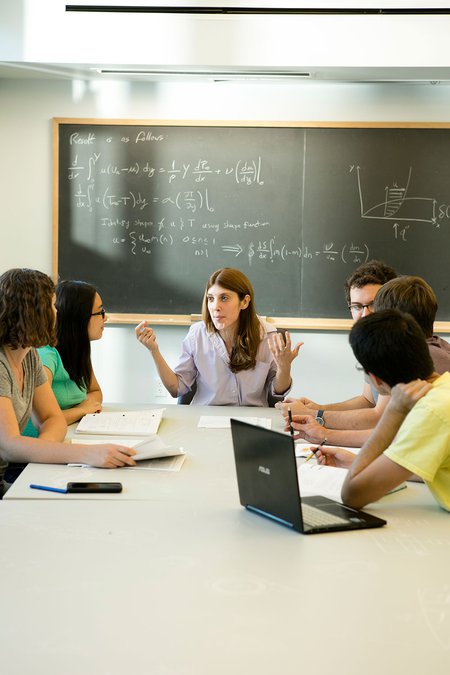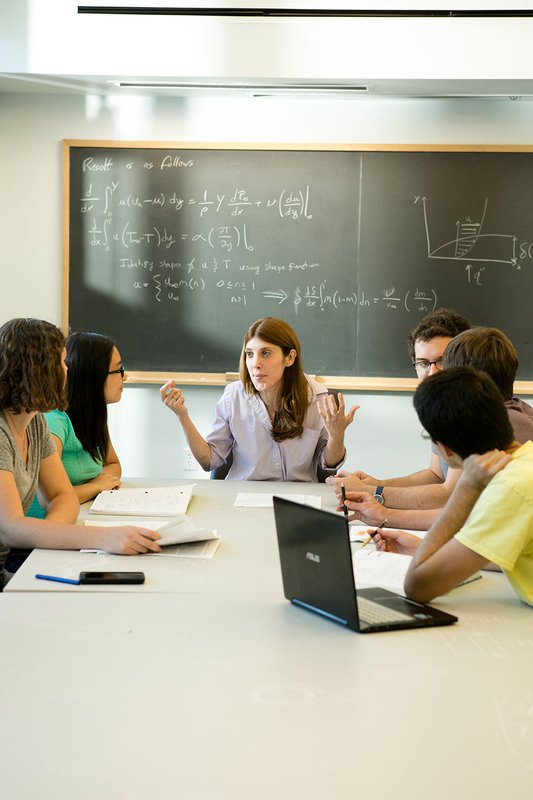Tucked away on the third floor of the Center for Student Services on Holliston Avenue, an office with five full-time employees has quietly transformed the ways Caltech teaches its students and future scientists.
Created in 2012, the Center for Teaching, Learning, & Outreach (CTLO) was launched with ambitious goals: to improve the quality of teaching on campus, bolster instructional opportunities for students, and engage K–12 schools in educational outreach. At the time, Caltech lacked a center specifically devoted to those ends.
Joseph Shepherd, vice president for student affairs, notes that five years later, though still small, CTLO has amassed a portfolio of several dozen programs that have had an outsized impact on education on campus and established itself "as an integral part of the Institute."
Cindy Weinstein, vice provost of education, notes that "the inaugural team impact award was awarded to the CTLO because it has worked effectively with faculty, students, and postdocs to enhance teaching and learning at Caltech."
The office has played a key role in improving the undergraduate core curriculum by updating teaching methods and seeking regular feedback from faculty and students about the approaches that worked best. The office also brings core and other faculty members together to discuss ways to improve the students' experience.
Several programs focus on training for faculty members and teaching assistants—including the annual fall Teaching Conference, TeachWeek, and the Faculty Summer Short Course. Other programs offer seminars and workshops featuring speakers, such as Caltech Feynman Teaching Prize winners and other guest speakers, to help teachers become more effective.
Timothy Liu, a senior in electrical engineering who was the student government's Academics and Research Committee chair for the 2016–17 academic year, says CTLO "has played a critical role in supporting and improving classroom instruction. Programs like TA training and cross-departmental discussions organized by CTLO have helped improve the classroom experience for students. Undergraduates can definitely see some of these newer ideas in teaching appear in the lecture hall and classroom."
More than 85 percent of the Institute's new and established faculty have participated in at least one the office's programs, says Cassandra Horii, who is a scientist by training and has served as director of CTLO since its inception in 2012. Horii adds that almost half of all faculty now participate in programs annually, showing "Caltech's depth of commitment to discussing meaningful questions about how students learn, something we're doing along with a lot of other universities in light of emerging research on effective teaching."
Xie Chen, associate professor of theoretical physics, is one of them. In January 2016, she sought help from CTLO to improve her Physics 129 b class.
"I was pretty new, and, after teaching the class once, I wanted to get my students more motivated and interested—I didn't want them to fall asleep," she jokes.
CTLO's assistant director for instructional practice & technology, Jennifer Weaver, sat in on a class and talked with Chen extensively on which active learning techniques would work for incorporation into her classroom. For example, they decided that Chen would break up her lecture by engaging students with thoughtful questions, allowing them time to consider, confer and respond.
Chen credits the experience with boosting her confidence and improving her students' interest and attendance—and also, in part, for her receiving a graduate student teaching award for her winter 2016–17 course.
"When I started, I was never systematically trained as a teacher. But CTLO helped me at a time when I really needed it," she adds.
CTLO's reach also extends into the community, where its programs cast students in the roles of teachers as part of educational outreach efforts that engaged about 17,500 local K–12 students and teachers last year. These popular programs include Visiting Scientists, which features graduate students and postdoctoral scholars who volunteer in local schools to conduct hands-on science lessons, and Science Night, in which Caltech undergraduates, graduate students, and postdoctoral scholars conduct science demonstrations for students and parents at local schools.
As part of the Visiting Scientists program, Cecilia Sanders, a second-year graduate student in geological and planetary sciences, recently coached a second-grade class at Pasadena Unified School District's Cleveland Elementary School through a hands-on exercise using color-coded paper representing genes to teach how snippets of DNA can determine an animal's color, size, and shape.
Sanders says she gained at least as much from the classroom experience as the children did. "I think it actually makes me a better scientist and thinker," she says. "You don't really understand something until you can explain it to a 6-year-old and get them to retain it."
In addition to in-person outreach, CTLO supports digital community outreach as well through massive open online courses (MOOCs) taught by Caltech faculty that have engaged more than 740,000 people all over the world.
Antonio Rangel, the Bing Professor of Neuroscience, Behavioral Biology, and Economics, says CTLO has had a significant impact on his teaching and research, and has been instrumental in creating and gradually improving his Ec 11 course, which has been using a flipped classroom model for the last four years and is also offered as an online course for non-Caltech students.
Working with the office, he says, gave him insights into "how to teach effectively on different media and led me to completely change the way I teach inside Caltech and online."
On-campus enrollment in Rangel's course has increased by about 80 percent, he says, and objective measures of learning, such as final test scores, have increased by about 20 percent.
Mitch Aiken, associate director for educational outreach, says CTLO's focus on outreach supports researchers' efforts to demonstrate the potential societal benefits of their work. Locally, CTLO programs offer assistance ranging from training high school students and teachers in rigorous research and data collection techniques to helping create and staff the 3-D Printing and Fracture Mechanics course for Muir High School's Engineering & Environmental Science Academy students. Caltech's Community Science Academy programs and the National Science Foundation-funded Pulsar Search Collaboratory have also prompted local students to seek careers in science—as well as an education at Caltech.
In the new year, CTLO will welcome a visit by Physics Nobel Prize winner Carl Wieman in February, who will speak about STEM education research. In April, Shirley Malcom, Caltech trustee and director of education and human resources programs at the American Association for the Advancement of Science, will speak at TeachWeek about national changes in science education.
Horii says that, going forward, CTLO aims to deepen its collaboration with academic divisions and work to create more discipline-specific resources and programs: "We're really excited about partnerships that meet faculty and TAs where they are, and we're always looking for new ways to empower Caltech's community of educators."
 More than 85 percent of the Institute's new and established faculty have participated in at least one CTLO program, and almost half of all faculty now participate in programs annually.
Credit: Max Gerber for Caltech
More than 85 percent of the Institute's new and established faculty have participated in at least one CTLO program, and almost half of all faculty now participate in programs annually.
Credit: Max Gerber for Caltech

